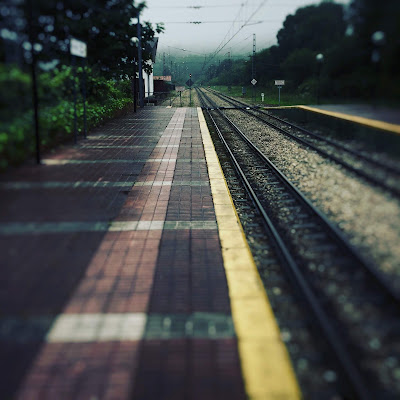A slow train through Asturias
As a long time commuter with a ridiculously expensive season ticket and regularly cursed early mornings you may think I would choose to avoid unnecessary rail travel. The daily mindless rush in hope of a seat followed by a disappointed perch on the luggage rack prior to a hard days graft should be enough to put anyone sensible off. But not all rail travel is as stressful as the work commute. There are rail journeys where you can really 'let the train take the strain', and spend the time daydreaming as mountains and wild coasts fill the windows whilst you rattle past tiny stations and fields full of flowers.
The FEVE (Ferrocaril Española Via Estrecha) is an eccentric, slightly erratic and totally charming local rail network than runs from the Basque country, through Asturias and Cantabria to Galicia in northern Spain. Recently, I had the pleasure of exploring part of this line, criss crossing routes through the verdant landscape of Asturias, perfectly described as Spain's 'Costa Verde', on a trip organised by Inn Travel.
The FEVE will at first frustrate your hardened commuter's 'my train cannot be late!' state of mind. Relax, let all that stress go, this service will make you fall back in love with travelling by train. You will smile at the ticket collector and find yourself waving at old ladies gossiping in their gardens as you trundle past. A narrow gauge line dating from the mid 60s it is not quaint or a beautifully restored vintage service, just a hard working local means of travel that makes stops at places so seemingly unprofitable that the UK would have axed them a century ago. Your very few (sometimes none) fellow passengers are locals, using the cheapest method of transport to get around. Stations vary, some are tiny, no more than a shelter in the middle of no where, others slightly larger with a uniformed station master and perhaps a tiny bar. You will notice other things too. Locals passing parcels or letters to the train driver to take further along the line, pots of geraniums tumbling across the platform, colourful graffiti spelling colourful language. It isn't fast but thats the point, instead of rushing from A to B, you'll have a chance to think, to see, to wonder, the perfect opportunity to take life at a slower pace.
The FEVE doesn't always run exactly to time but this will often work to your favour. Lingered too long over a late lunch and slowed by a little too much vino? Well, that train on the platform as you scurry over the track is very likely to wait for you, as the driver chats with the station master and sees your panicked red face. Standing at the tiny station of Pito Piñera waiting for the FEVE to Avilés, it only showed up at its due time in the opposite direction. It didn't matter, in the 20 minutes or so it took to come back I had counted at least 30 different wild flowers edging the platform and watched the cloud level sink silently down to hide the mountains. Slowing down is good for the soul.
I had a pre-paid ticket charged with a number of journeys with which you touched in and out at the gates. Many stations, however, were literally no more than a bench next the tracks in the middle of fields and tickets were checked by the occasional ticket inspector on the trains themselves. Uniformed and polite (and perhaps with slight surprise to see a tourist) they were very helpful with advice on changes to routes.
Moving between stations became an opportunity to catch glimpses of daily life in rural Spain. Elderly ladies were escorted onto the train by helpful daughters, a rural farm worker flirted outrageously with a younger girl who shrugged off his advances with a nonchalant smile. A man whiling away his hours with a bottle of cider laughed when he saw my urgent attempts to enter the station loo but helpfully nodded me in the direction of the station manager for the key. Many of the stations have small bars (so civilised), time for a quick café solo or something stronger to fortify your next few hours rattling through the Asturian countryside.
San Esteban to Pito Piñera, Pito Piñera to Avilés, then Cudillero to Oviedo and onwards to Ribadesella, the FEVE meanders along wide rivers where salmon fishermen cast their lines hopefully and Asturian cows watch from fields dotted with hórreos, the distinctive ancient grain stores found across the region. The train driver toots his horn regularly, I assume to alert anything on the line, rattling through a large group of trees, a stag leaped away in surprise, too quick for my camera. Occasional glimpses of hidden coves surprise you as the carriages twist around cloud covered mountains and underneath viaducts.
Sadly, I hear rumours that the future of this charming network is at risk. I hope not, it would be such a shame to lose such a wonderful (and environmentally friendly) way to explore this region. Perhaps as a growing awareness of the network by other travellers keen to take life a little slower gathers apace, it can rebuild its prospects and keep trundling along. Travelling on this network, I have slowed down and enjoyed the journey as much as the destination. The FEVE has done something amazing, it has melted this old commuter's ice cold heart.
Following on from my posts from my trip to Asturias, further posts are published on InnTravel's excellent The Slow Lane, inspirational tips and trips for taking life at a slower pace.
A Piper's Dream - following the bagpipe around the streets of Oviedo.
Welcome to Ribadesella - exploring this fantastic coastal town on the edge of the Picos de Europa.
Lunch at Arbidel - celebrating in style at chef Jaime Uz's Michelin starred restaurant.
The FEVE (Ferrocaril Española Via Estrecha) is an eccentric, slightly erratic and totally charming local rail network than runs from the Basque country, through Asturias and Cantabria to Galicia in northern Spain. Recently, I had the pleasure of exploring part of this line, criss crossing routes through the verdant landscape of Asturias, perfectly described as Spain's 'Costa Verde', on a trip organised by Inn Travel.
The FEVE will at first frustrate your hardened commuter's 'my train cannot be late!' state of mind. Relax, let all that stress go, this service will make you fall back in love with travelling by train. You will smile at the ticket collector and find yourself waving at old ladies gossiping in their gardens as you trundle past. A narrow gauge line dating from the mid 60s it is not quaint or a beautifully restored vintage service, just a hard working local means of travel that makes stops at places so seemingly unprofitable that the UK would have axed them a century ago. Your very few (sometimes none) fellow passengers are locals, using the cheapest method of transport to get around. Stations vary, some are tiny, no more than a shelter in the middle of no where, others slightly larger with a uniformed station master and perhaps a tiny bar. You will notice other things too. Locals passing parcels or letters to the train driver to take further along the line, pots of geraniums tumbling across the platform, colourful graffiti spelling colourful language. It isn't fast but thats the point, instead of rushing from A to B, you'll have a chance to think, to see, to wonder, the perfect opportunity to take life at a slower pace.
The FEVE doesn't always run exactly to time but this will often work to your favour. Lingered too long over a late lunch and slowed by a little too much vino? Well, that train on the platform as you scurry over the track is very likely to wait for you, as the driver chats with the station master and sees your panicked red face. Standing at the tiny station of Pito Piñera waiting for the FEVE to Avilés, it only showed up at its due time in the opposite direction. It didn't matter, in the 20 minutes or so it took to come back I had counted at least 30 different wild flowers edging the platform and watched the cloud level sink silently down to hide the mountains. Slowing down is good for the soul.
I had a pre-paid ticket charged with a number of journeys with which you touched in and out at the gates. Many stations, however, were literally no more than a bench next the tracks in the middle of fields and tickets were checked by the occasional ticket inspector on the trains themselves. Uniformed and polite (and perhaps with slight surprise to see a tourist) they were very helpful with advice on changes to routes.
Sadly, I hear rumours that the future of this charming network is at risk. I hope not, it would be such a shame to lose such a wonderful (and environmentally friendly) way to explore this region. Perhaps as a growing awareness of the network by other travellers keen to take life a little slower gathers apace, it can rebuild its prospects and keep trundling along. Travelling on this network, I have slowed down and enjoyed the journey as much as the destination. The FEVE has done something amazing, it has melted this old commuter's ice cold heart.
Following on from my posts from my trip to Asturias, further posts are published on InnTravel's excellent The Slow Lane, inspirational tips and trips for taking life at a slower pace.
A Piper's Dream - following the bagpipe around the streets of Oviedo.
Welcome to Ribadesella - exploring this fantastic coastal town on the edge of the Picos de Europa.
Lunch at Arbidel - celebrating in style at chef Jaime Uz's Michelin starred restaurant.











Comments
Post a Comment